sources
https://en.wikipedia.org/wiki/Caf%C3%A9_Terrace_at_Night
https://www.theguardian.com/artanddesign/2018/aug/25/vincent-van-gogh-details-period-france-asylum-revealed
https://www.notablebiographies.com/Tu-We/van-Gogh-Vincent.html
https://assets.moma.org/documents/moma_catalogue_1996_300061887.pdf
https://en.wikipedia.org/wiki/Early_works_of_Vincent_van_Gogh
https://en.wikipedia.org/wiki/Vincent_van_Gogh
https://www.vincentvangogh.org/starry-night-over-the-rhone.jsp
http://www.vggallery.com/letters/main.htm
https://www.brainpickings.org/2014/12/01/van-gogh-purpose-letter/
We all know he is the creator of The Legendary painting '' The starry night "
but what we don't know is there are a lot of other paintings which he painted.
Artist from the art world know about this but those who are not from the art world don't know much about his other work and don't know who he was. The reason -
- Almost every artist recreate '' THE STARRY NIGHT '' because that painting is one of the most emotional painting V.V.G made and it deserve all the love but what i feel is that artist have this duty to let their audience know about the artist whose work they are recreating, it helps the audience to connect to the art more.
To introduce people to V.V.G other works i will be doing a story with every art i feature here.
NOTE - I'm taking help from the articles i've been reading about him and will be putting them here with some editing and some original content. If you see something which is copied from somewhere else then you are right as it's a study so the whole content cannot be original.
Let's do the background story -
VINCENT VAN GOGH
( SELF PORTRAIT )
Like Rembrandt and Goya, ( BOTH ARTIST ) Vincent van Gogh often used himself as a model; he produced over forty-three self-portraits, paintings or drawings in ten years. Like the old masters, he observed himself critically in a mirror. Painting oneself is not an innocuous act: it is a questioning which often leads to an identity crisis.
Thus he wrote to his sister: "I am looking for a deeper likeness than that obtained by a photographer." And later to his brother: "People say, and I am willing to believe it, that it is hard to know yourself. But it is not easy to paint yourself, either. The portraits painted by Rembrandt are more than a view of nature, they are more like a revelation".
Description -
| Born | Vincent Willem van Gogh 30 March 1853 |
|---|---|
| Died | 29 July 1890 (aged 37) |
| Cause of death | Suicide by gunshot |
| Resting place | Cimetière d'Auvers-sur-Oise, France 49°04′31″N 2°10′44″E |
| Nationality | Dutch |
| Education | Anton Mauve |
| Known for | Painting, drawing |
Notable work | Sorrow (1882) The Potato Eaters (1885) Sunflowers (1887) Bedroom in Arles (1888) The Starry Night (1889) Portrait of Dr. Gachet (1890) Wheatfield with Crows (1890) |
| Movement | Post-Impressionism |
was a Dutch post-impressionist painter who is among the most famous and influential figures in the history of Western art. In just over a decade, he created about 2,100 artworks, including around 860 oil paintings, most of which date from the last two years of his life. They include landscapes, still lifes, portraits and self-portraits, and are characterised by bold colours and dramatic, impulsive and expressive brushwork that contributed to the foundations of modern art. He was not commercially successful, and his suicide at 37 came after years of mental illness, depression and poverty.
Vincent Van Gogh loved his brother THEO

THEO VAN GOGH ( brother of Vincent Van Gogh )
VINCENT use to write letters to his friends and family ( Theo, for the most part ) that is the only reason we can do a background story on him.
Dr. Jan Hulsker, one of the world's foremost authorities on the letters of Vincent van Gogh, once wrote of them:
There are 874 Van Gogh letters
(more than 850,000 words in total).
To see the complete letters visit -
http://www.vggallery.com/letters/main.htm
In one of his letters to his beloved brother that "We live in such a disturbed time that there can be no way of having firm enough opinions to form any judgement of things." This shows the sorrow he must have felt while being depressed.

Van Gogh's home in Cuesmes; while there he decided to become an artist
Early life
Vincent Willem van Gogh was born on 30 March 1853 into a Dutch Reformed Church family in Groot-Zundert, in the predominantly Catholic province of North Brabant in the Netherlands. He was the oldest surviving child of Theodorus van Gogh, a minister of the Dutch Reformed Church, and Anna Cornelia Carbentus. Van Gogh was given the name of his grandfather, and of a brother stillborn exactly a year before his birth. Vincent was a common name in the Van Gogh family: his grandfather, Vincent (1789–1874), who received a degree in theology at the University of Leiden in 1811, had six sons, three of whom became art dealers. This Vincent may have been named after his own great-uncle, a sculptor (1729–1802)
Van Gogh's parents married in May 1851 and moved to Zundert. His brother Theo was born on 1 May 1857. There was another brother, Cor, and three sisters: Elisabeth, Anna, and Willemina (known as "Wil"). In later life Van Gogh remained in touch only with Willemina and Theo. Van Gogh's mother was a rigid and religious woman who emphasised the importance of family to the point of claustrophobia for those around her. Theodorus's salary was modest, but the Church supplied the family with a house, a maid, two cooks, a gardener, a carriage and horse, and Anna instilled in the children a duty to uphold the family's high social position.
NOW WHAT YOU ARE READING MIGHT BE THE REASON WHY VINCENT VAN GOGH BECAME A ARTIST AND WHERE THE FIRST SEED OF DEPRESSION WAS PLANTED.
Van Gogh was a serious and thoughtful child. He was taught at home by his mother and a governess, and in 1860 was sent to the village school. In 1864, he was placed in a boarding school at Zevenbergen, where he felt abandoned, and campaigned to come home. Instead, in 1866 his parents sent him to the middle school in Tilburg, where he was deeply unhappy. His interest in art began at a young age. He was encouraged to draw as a child by his mother, and his early drawings are expressive, but do not approach the intensity of his later work. Constant Cornelis Huijsmans, who had been a successful artist in Paris, taught the students at Tilburg. His philosophy was to reject technique in favour of capturing the impressions of things, particularly nature or common objects. Van Gogh's profound unhappiness seems to have overshadowed the lessons, which had little effect. In March 1868, he abruptly returned home. He later wrote that his youth was "austere and cold, and sterile"
HIS YOUTH WAS AUSTERE & COLD
( a way of life having no comforts or luxuries & lacking affection or warmth of feeling; unemotional. )
When a person describe a period of life like that you can feel how much pain he must be in and how he must have been living a life like that for so long. )
FROM HIS 20s to HIS 30s
A JOURNEY FROM WORKING IN ART DEALING COMPANY TO A BOOKSELLER TO A PASTOR TO FINALLY WHAT HE WAS DESTINED TO BE AN ARTIST.
In April 1876 he returned to England to take unpaid work as a supply teacher in a small boarding school in Ramsgate. When the proprietor moved to Isleworth in Middlesex, Van Gogh went with him. The arrangement did not work out and he left to become a Methodist minister's assistant. His parents had meanwhile moved to Etten. in 1876 he returned home at Christmas for six months and took work at a bookshop in Dordrecht. He was unhappy in the position and spent his time doodling or translating passages from the Bible into English, French and German.He immersed himself in religion, and became increasingly pious and monastic. According to his flatmate of the time, Paulus van Görlitz, Van Gogh ate frugally, avoiding meat.
To support his religious conviction and his desire to become a pastor, in 1877 the family sent him to live with his uncle Johannes Stricker, a respected theologian, in Amsterdam. Van Gogh prepared for the University of Amsterdam theology entrance examination; he failed the exam, and left his uncle's house in July 1878. He undertook, but also failed, a three-month course at a Protestant missionary school in Laken, near Brussels.
In January 1879 he took up a post as a missionary at Petit-Wasmes, in the coal-mining district of Borinage in Belgium. To show support for his impoverished congregation, he gave up his comfortable lodgings at a bakery to a homeless person, and moved to a small hut where he slept on straw. His squalid living conditions did not endear him to church authorities, who dismissed him for "undermining the dignity of the priesthood". He then walked the 75 kilometres (47 mi) to Brussels,returned briefly to Cuesmes in the Borinage, but gave in to pressure from his parents to return home to Etten. He stayed there until around March 1880, which caused concern and frustration for his parents. His father was especially frustrated and advised that his son should be committed to the lunatic asylum at Geel.
Van Gogh returned to Cuesmes in August 1880, where he lodged with a miner until October. He became interested in the people and scenes around him, and recorded them in drawings after Theo's suggestion that he take up art in earnest. He travelled to Brussels later in the year, to follow Theo's recommendation that he study with the Dutch artist Willem Roelofs, who persuaded him – in spite of his dislike of formal schools of art – to attend the Académie Royale des Beaux-Arts. He registered at the Académie in November 1880, where he studied anatomy and the standard rules of modelling and perspective.
Early works of Vincent van Gogh
| The Sower (after Millet) | |
|---|---|
 | |
| Artist | Vincent van Gogh |
| Year | 1881 |
| Type | Pen and watercolor on paper |
| Dimensions | 48.1 cm × 36.7 cm (18.9 in × 14.4 in) |
| Location | Kröller-Müller Museum, Otterlo, Netherlands |
Etten, Drenthe and The Hague
In April 1881, Van Gogh moved to the Etten (Noord-Brabant) countryside in the Netherlands with his parents where he continued drawing, often using neighbors as subjects. Through the summer he spent much time walking and talking with his recently widowed cousin, Kee Vos-Stricker. She was the daughter of his mother's older sister and Johannes Stricker, who had shown warmth towards the artist. Although Van Gogh would have liked to marry Stricker, given her decisive refusal: "No, never, never" (niet, nooit, nimmer) and his inability to support himself financially, marriage was out of the question. Van Gogh was hurt deeply. That Christmas he quarreled violently with his father, to the point of refusing a gift of money, and left for The Hague.
In January 1882, he settled in The Hague where he called on his cousin-in-law, the painter Anton Mauve (1838–88). Mauve introduced him to painting in both oil and watercolor and lent him money to set up a studio; however the two soon fell out, possibly over the issue of drawing from plaster casts. Mauve appears to have suddenly gone cold towards Van Gogh and did not return a number of his letters, Van Gogh supposed that Mauve did not approve of his domestic arrangement with an alcoholic prostitute, Clasina Maria "Sien" Hoornik (1850–1904) and her young daughter.He had met Sien towards the end of January, when she had a five-year-old daughter and was pregnant. On 2 July, Sien gave birth to a baby boy, Willem. Van Gogh's father put considerable pressure on his son to abandon Sien and her children. Vincent was at first defiant in the face of opposition.
Van Gogh's art dealer uncle, Cornelis, commissioned 20 ink drawings of the city, which the artist completed by the end of May.That June, he spent three weeks in a hospital suffering from gonorrhea. That summer he began to paint in oil. In autumn 1883, after a year together, he left Sien and the two children.Van Gogh moved to the Dutch province of Drenthe, in the northern Netherlands. That December, driven by loneliness, he went to stay with his parents who were by then living in Nuenen, North Brabant.
Development as an artist
Van Gogh drew and painted with watercolors while at school; few of these works survive and authorship is challenged on some of those that do. When he committed to art as an adult, he began at an elementary level by copying the Cours de dessin, edited by Charles Bargue and published by Goupil & Cie. Within two years he had begun to seek commissioned. In Spring 1882, his uncle, Cornelis Marinus - owner of a renowned gallery of contemporary art in Amsterdam - asked him for drawings of the Hague. Van Gogh's work did not prove equal to his uncle's expectations. Marinus offered a second commission, this time specifying the subject matter in detail, but was once again disappointed with the result. Nevertheless, Van Gogh persevered. He improved the lighting of his studio by installing variable shutters and experimented with a variety of drawing materials. For more than a year he worked on single figures —highly elaborated studies in "Black and White", which at the time gained him only criticism. Today, they are recognized as his first masterpieces.
EMERGING ARTIST
Emerging artist
Nuenen and Antwerp (1883–1886)
In Nuenen, Van Gogh focused on painting and drawing. Working outside and very quickly, he completed sketches and paintings of weavers and their cottages. Van Gogh also completed The Parsonage Garden at Nuenen, which was stolen from the Singer Laren in March 2020. From August 1884, Margot Begemann, a neighbour's daughter ten years his senior, joined him on his forays; she fell in love and he reciprocated, though less enthusiastically. They wanted to marry, but neither side of their families were in favour. Margot was distraught and took an overdose of strychnine, but survived after Van Gogh rushed her to a nearby hospital.On 26 March 1885, his father died of a heart attack.
Van Gogh painted several groups of still lifes in 1885. During his two-year stay in Nuenen, he completed numerous drawings and watercolours, and nearly 200 oil paintings. His palette consisted mainly of sombre earth tones, particularly dark brown, and showed no sign of the vivid colours that distinguish his later work.
There was interest from a dealer in Paris early in 1885. Theo asked Vincent if he had paintings ready to exhibit.[In May, Van Gogh responded with his first major work, The Potato Eaters, and a series of "peasant character studies" which were the culmination of several years of work. When he complained that Theo was not making enough effort to sell his paintings in Paris, his brother responded that they were too dark, and not in keeping with the bright style of Impressionism. In August his work was publicly exhibited for the first time, in the shop windows of the dealer Leurs in The Hague. One of his young peasant sitters became pregnant in September 1885; Van Gogh was accused of forcing himself upon her, and the village priest forbade parishioners to model for him.
He moved to Antwerp that November, and rented a room above a paint dealer's shop in the rue des Images (Lange Beeldekensstraat). He lived in poverty and ate poorly, preferring to spend the money Theo sent on painting materials and models. Bread, coffee and tobacco became his staple diet. In February 1886, he wrote to Theo that he could only remember eating six hot meals since the previous May. His teeth became loose and painful. In Antwerp he applied himself to the study of colour theory and spent time in museums—particularly studying the work of Peter Paul Rubens—and broadened his palette to include carmine, cobalt blue and emerald green. Van Gogh bought Japanese ukiyo-e woodcuts in the docklands, later incorporating elements of their style into the background of some of his paintings. He was drinking heavily again, and was hospitalised between February and March 1886, when he was possibly also treated for syphilis.
After his recovery, and despite his antipathy towards academic teaching, he took the higher-level admission exams at the Academy of Fine Arts in Antwerp, and in January 1886 matriculated in painting and drawing. He became ill and run down by overwork, poor diet and excessive smoking. He started to attend drawing classes after plaster models at the Antwerp Academy on 18 January 1886. He quickly got into trouble with Charles Verlat, the director of the Academy and teacher of a painting class, because of his unconventional painting style. Van Gogh had also clashed with the instructor of the drawing class Franz Vinck. Van Gogh finally started to attend the drawing classes after antique plaster models given by Eugène Siberdt. Soon Siberdt and Van Gogh came into conflict when the latter did not comply with Siberdt's requirement that drawings express the contour and concentrate on the line. When Van Gogh was required to draw the Venus of Milo during a drawing class, he produced the limbless, naked torso of a Flemish peasant woman. Siberdt regarded this as defiance against his artistic guidance and made corrections to Van Gogh's drawing with his crayon so vigorously that he tore the paper. Van Gogh then flew into a violent rage and shouted at Siberdt: 'You clearly do not know what a young woman is like, God damn it! A woman must have hips, buttocks, a pelvis in which she can carry a baby!' According to some accounts this was the last time Van Gogh attended classes at the Academy and he left later for Paris. On 31 March 1886, which was about a month after the confrontation with Siberdt, the teachers of the Academy decided that 17 students, including Van Gogh, had to repeat a year. The story that Van Gogh was expelled from the Academy by Siberdt is therefore unfounded.
LIFE IN PARIS (1886–1888)
Van Gogh moved to Paris in March 1886 where he shared Theo's rue Laval apartment in Montmartre, and studied at Fernand Cormon's studio. In June the brothers took a larger flat at 54 rue Lepic. In Paris, Vincent painted portraits of friends and acquaintances, still life paintings, views of Le Moulin de la Galette, scenes in Montmartre, Asnières and along the Seine. In 1885 in Antwerp he had become interested in Japanese ukiyo-e woodblock prints, and had used them to decorate the walls of his studio; while in Paris he collected hundreds of them. He tried his hand at Japonaiserie, tracing a figure from a reproduction on the cover of the magazine Paris Illustre, The Courtesan or Oiran (1887), after Keisai Eisen, which he then graphically enlarged in a painting.
After seeing the portrait of Adolphe Monticelli at the Galerie Delareybarette, Van Gogh adopted a brighter palette and a bolder attack, particularly in paintings such as his Seascape at Saintes-Maries (1888). Two years later, Vincent and Theo paid for the publication of a book on Monticelli paintings, and Vincent bought some of Monticelli's works to add to his collection.
Van Gogh learned about Fernand Cormon's atelier from Theo. He worked at the studio in April and May 1886,where he frequented the circle of the Australian artist John Peter Russell, who painted his portrait in 1886. Van Gogh also met fellow students Émile Bernard, Louis Anquetin and Henri de Toulouse-Lautrec – who painted a portrait of him in pastel. They met at Julien "Père" Tanguy's paint shop, (which was, at that time, the only place where Paul Cézanne's paintings were displayed). In 1886, two large exhibitions were staged there, showing Pointillism and Neo-impressionism for the first time, and bringing attention to Georges Seurat and Paul Signac. Theo kept a stock of Impressionist paintings in his gallery on boulevard Montmartre, but Van Gogh was slow to acknowledge the new developments in art.
Conflicts arose between the brothers. At the end of 1886 Theo found living with Vincent to be "almost unbearable". By early 1887, they were again at peace, and Vincent had moved to Asnières, a northwestern suburb of Paris, where he got to know Signac. He adopted elements of Pointillism, a technique in which a multitude of small coloured dots are applied to the canvas so that when seen from a distance they create an optical blend of hues. The style stresses the ability of complementary colours – including blue and orange – to form vibrant contrasts.
While in Asnières Van Gogh painted parks, restaurants and the Seine, including Bridges across the Seine at Asnières. In November 1887, Theo and Vincent befriended Paul Gauguin who had just arrived in Paris. Towards the end of the year, Vincent arranged an exhibition alongside Bernard, Anquetin, and probably Toulouse-Lautrec, at the Grand-Bouillon Restaurant du Chalet, 43 avenue de Clichy, Montmartre. In a contemporary account, Bernard wrote that the exhibition was ahead of anything else in Paris. There, Bernard and Anquetin sold their first paintings, and Van Gogh exchanged work with Gauguin. Discussions on art, artists, and their social situations started during this exhibition, continued and expanded to include visitors to the show, like Camille Pissarro and his son Lucien, Signac and Seurat. In February 1888, feeling worn out from life in Paris, Van Gogh left, having painted more than 200 paintings during his two years there. Hours before his departure, accompanied by Theo, he paid his first and only visit to Seurat in his studio.
Artistic breakthrough
Arles (1888–89)
Ill from drink and suffering from smoker's cough, in February 1888 Van Gogh sought refuge in Arles. He seems to have moved with thoughts of founding an art colony. The Danish artist Christian Mourier-Petersen became his companion for two months, and at first Arles appeared exotic. In a letter, he described it as a foreign country: "The Zouaves, the brothels, the adorable little Arlésienne going to her First Communion, the priest in his surplice, who looks like a dangerous rhinoceros, the people drinking absinthe, all seem to me creatures from another world."
The time in Arles became one of Van Gogh's more prolific periods: he completed 200 paintings, and more than 100 drawings and watercolours. He was enchanted by the local countryside and light; his works from this period are rich in yellow, ultramarine and mauve. His paintings include harvests, wheat fields and general rural landmarks from the area, including The Old Mill (1888), a picturesque structure bordering the wheat fields. This was one of seven canvases sent to Pont-Aven on 4 October 1888 in an exchange of works with Paul Gauguin, Émile Bernard, Charles Laval and others.
The portrayals of Arles are informed by Van Gogh's Dutch upbringing; the patchworks of fields and avenues appear flat and lacking perspective, but excel in their use of colour. His new-found appreciation is seen in the range and scope of his work. In March 1888 he painted landscapes using a gridded "perspective frame"; three of the works were shown at the annual exhibition of the Société des Artistes Indépendants. In April, he was visited by the American artist Dodge MacKnight, who was living nearby at Fontvieille. On 1 May 1888, for 15 francs per month, he signed a lease for the eastern wing of the Yellow House at 2 place Lamartine. The rooms were unfurnished and had been uninhabited for months.
On 7 May, Van Gogh moved from the Hôtel Carrel to the Café de la Gare,[123] having befriended the proprietors, Joseph and Marie Ginoux. The Yellow House had to be furnished before he could fully move in, but he was able to use it as a studio.[124] He wanted a gallery to display his work, and started a series of paintings that eventually included Van Gogh's Chair (1888), Bedroom in Arles (1888), The Night Café (1888), Café Terrace at Night (September 1888), Starry Night Over the Rhone (1888), and Still Life: Vase with Twelve Sunflowers (1888), all intended for the decoration for the Yellow House.[125]
Van Gogh wrote that with The Night Café he tried "to express the idea that the café is a place where one can ruin oneself, go mad, or commit a crime".[126] When he visited Saintes-Maries-de-la-Mer in June, he gave lessons to a Zouave second lieutenant – Paul-Eugène Milliet[127] – and painted boats on the sea and the village.[128] MacKnight introduced Van Gogh to Eugène Boch, a Belgian painter who sometimes stayed in Fontvieille, and the two exchanged visits in July.[127]
Gauguin's visit (1888)
When Gauguin agreed to visit Arles in 1888, Van Gogh hoped for friendship, and the realisation of his idea of an artists' collective. While waiting, in August he painted Sunflowers. When Boch visited again, Van Gogh painted a portrait of him, as well as the study The Poet Against a Starry Sky.[129][note 7]
In preparation for Gauguin's visit, Van Gogh bought two beds on advice from the station's postal supervisor Joseph Roulin, whose portrait he painted. On 17 September, he spent his first night in the still sparsely furnished Yellow House.[131] When Gauguin consented to work and live in Arles with him, Van Gogh started to work on the Décoration for the Yellow House, probably the most ambitious effort he ever undertook.[132] He completed two chair paintings: Van Gogh's Chair and Gauguin's Chair.[133]
After much pleading from Van Gogh, Gauguin arrived in Arles on 23 October, and in November the two painted together. Gauguin depicted Van Gogh in his The Painter of Sunflowers; Van Gogh painted pictures from memory, following Gauguin's suggestion. Among these "imaginative" paintings is Memory of the Garden at Etten.[134][note 8] Their first joint outdoor venture was at the Alyscamps, when they produced the pendants Les Alyscamps.[135] The single painting Gauguin completed during his visit was Van Gogh Painting Sunflowers.[136]
Van Gogh and Gauguin visited Montpellier in December 1888, where they saw works by Courbet and Delacroix in the Musée Fabre.[137] Their relationship began to deteriorate; Van Gogh admired Gauguin and wanted to be treated as his equal, but Gauguin was arrogant and domineering, which frustrated Van Gogh. They often quarrelled; Van Gogh increasingly feared that Gauguin was going to desert him, and the situation, which Van Gogh described as one of "excessive tension", rapidly headed towards crisis point.[138]
Hospital in Arles (December 1888)
The exact sequence of events which led to Van Gogh's mutilation of his ear is not known. Gauguin stated, 15 years later, that the night followed several instances of physically threatening behaviour.[140] Their relationship was complex, and Theo may have owed money to Gauguin, who was suspicious that the brothers were exploiting him financially.[141] It seems likely that Van Gogh had realised that Gauguin was planning to leave.[141] The following days saw heavy rain, leading to the two men being shut in the Yellow House.[142] Gauguin reported that Van Gogh followed when Gauguin left the house for a walk, and "rushed towards me, an open razor in his hand".[142] This account is uncorroborated;[143] Gauguin was almost certainly absent from the Yellow House that night, most likely in a hotel.[142]
After the altercation with Gauguin, Van Gogh returned to his room, where he was assaulted by voices and severed his left ear with a razor (either wholly or in part; accounts differ),[note 9] causing severe bleeding.[144] He bandaged the wound, wrapped the ear in paper, and delivered the package to a woman at a brothel Van Gogh and Gauguin both frequented.[144] Van Gogh was found unconscious the next morning by a policeman and taken to hospital,[147][148] where Félix Rey, a young doctor still in training, treated him. The ear was delivered to the hospital, but Rey did not attempt to reattach it as too much time had passed.[142]
Van Gogh had no recollection of the event, suggesting that he may have suffered an acute mental breakdown.[149] The hospital diagnosis was "acute mania with generalised delirium",[150] and within a few days the local police ordered that he be placed in hospital care.[151][152] Gauguin immediately notified Theo, who on 24 December had proposed marriage to his old friend Andries Bonger's sister Johanna.[153] That evening Theo rushed to the station to board a night train to Arles. He arrived on Christmas Day and comforted Vincent, who seemed to be semi-lucid. That evening he left Arles for the return trip to Paris.[154]
During the first days of his treatment, Van Gogh repeatedly and unsuccessfully asked for Gauguin, who asked a policeman attending the case to "be kind enough, Monsieur, to awaken this man with great care, and if he asks for me tell him I have left for Paris; the sight of me might prove fatal for him."[155] Gauguin fled Arles, never to see Van Gogh again. They continued to correspond and in 1890 Gauguin proposed they form a studio in Antwerp. Meanwhile, other visitors to the hospital included Marie Ginoux and Roulin.[156]
Despite a pessimistic diagnosis, Van Gogh recovered and returned to the Yellow House on 7 January 1889.[157] He spent the following month between hospital and home, suffering from hallucinations and delusions of poisoning.[158] In March, the police closed his house after a petition by 30 townspeople (including the Ginoux family) who described him as "le fou roux" (the redheaded madman);[151] Van Gogh returned to hospital. Paul Signac visited him twice in March;[159] in April Van Gogh moved into rooms owned by Dr Rey after floods damaged paintings in his own home.[160] Two months later, he left Arles and voluntarily entered an asylum in Saint-Rémy-de-Provence. Around this time, he wrote, "Sometimes moods of indescribable anguish, sometimes moments when the veil of time and fatality of circumstances seemed to be torn apart for an instant."[161]
Van Gogh gave his 1889 Portrait of Doctor Félix Rey to Dr Rey. The physician was not fond of the painting and used it to repair a chicken coop, then gave it away.[162] In 2016, the portrait was housed at the Pushkin Museum of Fine Arts and estimated to be worth over $50 million.[163]
Saint-Rémy (May 1889 – May 1890)
Van Gogh entered the Saint-Paul-de-Mausole asylum on 8 May 1889, accompanied by his caregiver, Frédéric Salles, a Protestant clergyman. Saint-Paul was a former monastery in Saint-Rémy, located less than 30 kilometres (19 mi) from Arles, and was run by a former naval doctor, Théophile Peyron. Van Gogh had two cells with barred windows, one of which he used as a studio.[164] The clinic and its garden became the main subjects of his paintings. He made several studies of the hospital's interiors, such as Vestibule of the Asylum and Saint-Rémy (September 1889). Some of his works from this time are characterised by swirls, such as The Starry Night. He was allowed short supervised walks, during which time he painted cypresses and olive trees, including Olive Trees with the Alpilles in the Background 1889, Cypresses 1889, Cornfield with Cypresses (1889), Country road in Provence by Night (1890). In September 1889 he produced two further versions of Bedroom in Arles.[165]
Limited access to life outside the clinic resulted in a shortage of subject matter. Van Gogh instead worked on interpretations of other artist's paintings, such as Millet's The Sower and Noonday Rest, and variations on his own earlier work. Van Gogh was an admirer of the Realism of Jules Breton, Gustave Courbet and Millet,[166] and he compared his copies to a musician's interpreting Beethoven.[167]
His Prisoners' Round (after Gustave Doré) (1890) was painted after an engraving by Gustave Doré (1832–1883). Tralbaut suggests that the face of the prisoner in the centre of the painting looking towards the viewer is Van Gogh himself;[168] Jan Hulsker discounts this.[169]
Between February and April 1890, Van Gogh suffered a severe relapse. Depressed and unable to bring himself to write, he was still able to paint and draw a little during this time,[170] and he later wrote to Theo that he had made a few small canvases "from memory ... reminisces of the North".[171] Among these was Two Peasant Women Digging in a Snow-Covered Field at Sunset. Hulsker believes that this small group of paintings formed the nucleus of many drawings and study sheets depicting landscapes and figures that Van Gogh worked on during this time. He comments that this short period was the only time that Van Gogh's illness had a significant effect on his work.[172] Van Gogh asked his mother and his brother to send him drawings and rough work he had done in the early 1880s so he could work on new paintings from his old sketches.[173] Belonging to this period is Sorrowing Old Man ("At Eternity's Gate"), a colour study Hulsker describes as "another unmistakable remembrance of times long past".[92][174] His late paintings show an artist at the height of his abilities, according to the art critic Robert Hughes, "longing for concision and grace".[116]
Albert Aurier praised his work in the Mercure de France in January 1890, and described him as "a genius".[175] In February, Van Gogh painted five versions of L'Arlésienne (Madame Ginoux), based on a charcoal sketch Gauguin had produced when she sat for both artists in November 1888.[176][note 10] Also in February, Van Gogh was invited by Les XX, a society of avant-garde painters in Brussels, to participate in their annual exhibition. At the opening dinner a Les XX member, Henry de Groux, insulted Van Gogh's work. Toulouse-Lautrec demanded satisfaction, and Signac declared he would continue to fight for Van Gogh's honour if Lautrec surrendered. De Groux apologised for the slight and left the group. Later, while Van Gogh's exhibit was on display with the Artistes Indépendants in Paris, Claude Monet said that his work was the best in the show.[177] After the birth of his nephew, Van Gogh wrote, "I started right away to make a picture for him, to hang in their bedroom, branches of white almond blossom against a blue sky."[178]
Auvers-sur-Oise (May–July 1890)
In May 1890, Van Gogh left the clinic in Saint-Rémy to move nearer to both Dr Paul Gachet in the Paris suburb of Auvers-sur-Oise and to Theo. Gachet was an amateur painter and had treated several other artists – Camille Pissarro had recommended him. Van Gogh's first impression was that Gachet was "iller than I am, it seemed to me, or let's say just as much."[179]
The painter Charles Daubigny moved to Auvers in 1861, and in turn drew other artists there, including Camille Corot and Honoré Daumier. In July 1890, Van Gogh completed two paintings of Daubigny's Garden, one of which is likely his final work.[180]
During his last weeks at Saint-Rémy, his thoughts returned to "memories of the North",[171] and several of the approximately 70 oils, painted during as many days in Auvers-sur-Oise, are reminiscent of northern scenes.[181] In June 1890, he painted several portraits of his doctor, including Portrait of Dr Gachet, and his only etching. In each the emphasis is on Gachet's melancholic disposition.[182] There are other paintings which are probably unfinished, including Thatched Cottages by a Hill.[180]
In July, Van Gogh wrote that he had become absorbed "in the immense plain against the hills, boundless as the sea, delicate yellow".[183] He had first become captivated by the fields in May, when the wheat was young and green. In July, he described to Theo "vast fields of wheat under turbulent skies".[184]
He wrote that they represented his "sadness and extreme loneliness", and that the "canvases will tell you what I cannot say in words, that is, how healthy and invigorating I find the countryside".[185] Wheatfield with Crows, although not his last oil work, is from July 1890 and Hulsker discusses it as being associated with "melancholy and extreme loneliness".[186] Hulsker identifies seven oil paintings from Auvers that follow the completion of Wheatfield with Crows.[187]
Death
On 27 July 1890, aged 37, Van Gogh shot himself in the chest with a 7mm Lefaucheux à broche revolver.[188][189] There were no witnesses and he died 30 hours after the incident.[162] The shooting may have taken place in the wheat field in which he had been painting, or a local barn.[190] The bullet was deflected by a rib and passed through his chest without doing apparent damage to internal organs – probably stopped by his spine. He was able to walk back to the Auberge Ravoux, where he was attended to by two doctors, but without a surgeon present the bullet could not be removed. The doctors tended to him as best they could, then left him alone in his room, smoking his pipe. The following morning Theo rushed to his brother's side, finding him in good spirits. But within hours Vincent began to fail, suffering from an untreated infection resulting from the wound. He died in the early hours of 29 July. According to Theo, Vincent's last words were: "The sadness will last forever".[191][192][193][194]
Van Gogh was buried on 30 July, in the municipal cemetery of Auvers-sur-Oise. The funeral was attended by Theo van Gogh, Andries Bonger, Charles Laval, Lucien Pissarro, Émile Bernard, Julien Tanguy and Paul Gachet, among twenty family members, friends and locals. Theo had been ill, and his health began to decline further after his brother's death. Weak and unable to come to terms with Vincent's absence, he died on 25 January 1891 at Den Dolder, and was buried in Utrecht.[195] In 1914, Johanna van Gogh-Bonger had Theo's body exhumed and moved from Utrecht to be re-buried alongside Vincent's at Auvers-sur-Oise.[196]
There have been numerous debates as to the nature of Van Gogh's illness and its effect on his work, and many retrospective diagnoses have been proposed. The consensus is that Van Gogh had an episodic condition with periods of normal functioning.[197] Perry was the first to suggest bipolar disorder in 1947,[198] and this has been supported by the psychiatrists Hemphill and Blumer.[199][200] Biochemist Wilfred Arnold has countered that the symptoms are more consistent with acute intermittent porphyria, noting that the popular link between bipolar disorder and creativity might be spurious.[197] Temporal lobe epilepsy with bouts of depression has also been suggested.[200] Whatever the diagnosis, his condition was likely worsened by malnutrition, overwork, insomnia and alcohol.[200]
The gun van Gogh was reputed to have used was rediscovered in 1965 and was auctioned, on 19 June 2019, as "the most famous weapon in art history". The gun sold for €162,500 (£144,000; $182,000), almost three times more than expected.[201][202][203]
Style and works
Artistic development
Van Gogh drew, and painted with watercolours while at school, but only a few examples survive and the authorship of some has been challenged.[204] When he took up art as an adult, he began at an elementary level. In early 1882, his uncle, Cornelis Marinus, owner of a well-known gallery of contemporary art in Amsterdam, asked for drawings of The Hague. Van Gogh's work did not live up to expectations. Marinus offered a second commission, specifying the subject matter in detail, but was again disappointed with the result. Van Gogh persevered; he experimented with lighting in his studio using variable shutters, and with different drawing materials. For more than a year he worked on single figures – highly elaborate studies in black and white,[note 11] which at the time gained him only criticism. Later, they were recognised as early masterpieces.[206]
In August 1882 Theo gave Vincent money to buy materials for working en plein air. Vincent wrote that he could now "go on painting with new vigour".[207] From early 1883 he worked on multi-figure compositions. He had some of them photographed, but when his brother remarked that they lacked liveliness and freshness, he destroyed them and turned to oil painting. Van Gogh turned to well-known Hague School artists like Weissenbruch and Blommers, and received technical advice from them, as well as from painters like De Bock and Van der Weele, both of the Hague School's second generation.[208] When he moved to Nuenen after the period in Drenthe he began several large paintings but destroyed most of them. The Potato Eaters and its companion pieces are the only ones to have survived.[208] Following a visit to the Rijksmuseum, Van Gogh wrote of his admiration for the quick, economical brushwork of the Dutch Masters, especially Rembrandt and Frans Hals.[209][note 12] He was aware that many of his faults were due to lack of experience and technical expertise,[208] so in November 1885 he travelled to Antwerp and later Paris to learn and develop his skills.[210]
Theo criticised The Potato Eaters for its dark palette, which he thought unsuitable for a modern style.[211] During Van Gogh's stay in Paris between 1886 and 1887, he tried to master a new, lighter palette. His Portrait of Père Tanguy (1887) shows his success with the brighter palette, and is evidence of an evolving personal style.[212] Charles Blanc's treatise on colour interested him greatly, and led him to work with complementary colours. Van Gogh came to believe that the effect of colour went beyond the descriptive; he said that "colour expresses something in itself".[213][214] According to Hughes, Van Gogh perceived colour as having a "psychological and moral weight", as exemplified in the garish reds and greens of The Night Cafe, a work he wanted to "express the terrible passions of humanity".[215] Yellow meant the most to him, because it symbolised emotional truth. He used yellow as a symbol for sunlight, life, and God.[216]
Van Gogh strove to be a painter of rural life and nature,[217] and during his first summer in Arles he used his new palette to paint landscapes and traditional rural life.[218] His belief that a power existed behind the natural led him to try to capture a sense of that power, or the essence of nature in his art, sometimes through the use of symbols.[219] His renditions of the sower, at first copied from Jean-François Millet, reflect Van Gogh's religious beliefs: the sower as Christ sowing life beneath the hot sun.[220] These were themes and motifs he returned to often to rework and develop.[221] His paintings of flowers are filled with symbolism, but rather than use traditional Christian iconography he made up his own, where life is lived under the sun and work is an allegory of life.[222] In Arles, having gained confidence after painting spring blossoms and learning to capture bright sunlight, he was ready to paint The Sower.[213]
Van Gogh stayed within what he called the "guise of reality",[223] and was critical of overly stylised works.[224] He wrote afterwards that the abstraction of Starry Night had gone too far and that reality had "receded too far in the background".[224] Hughes describes it as a moment of extreme visionary ecstasy: the stars are in a great whirl, reminiscent of Hokusai's Great Wave, the movement in the heaven above is reflected by the movement of the cypress on the earth below, and the painter's vision is "translated into a thick, emphatic plasma of paint".[225]
Between 1885 and his death in 1890, Van Gogh appears to have been building an oeuvre,[226] a collection that reflected his personal vision, and could be commercially successful. He was influenced by Blanc's definition of style, that a true painting required optimal use of colour, perspective and brushstrokes. Van Gogh applied the word "purposeful" to paintings he thought he had mastered, as opposed to those he thought of as studies.[227] He painted many series of studies;[223] most of which were still lifes, many executed as colour experiments or as gifts to friends.[228] The work in Arles contributed considerably to his oeuvre: those he thought the most important from that time were The Sower, Night Cafe, Memory of the Garden in Etten and Starry Night. With their broad brushstrokes, inventive perspectives, colours, contours and designs, these paintings represent the style he sought.
Major series
Van Gogh's stylistic developments are usually linked to the periods he spent living in different places across Europe. He was inclined to immerse himself in local cultures and lighting conditions, although he maintained a highly individual visual outlook throughout. His evolution as an artist was slow, and he was aware of his painterly limitations. He moved home often, perhaps to expose himself to new visual stimuli, and through exposure develop his technical skill.Art historian Melissa McQuillan believes the moves also reflect later stylistic changes, and that Van Gogh used the moves to avoid conflict, and as a coping mechanism for when the idealistic artist was faced with the realities of his then current situation.
Portraits
The portraits gave Van Gogh his best opportunity to earn. He believed they were "the only thing in painting that moves me deeply and that gives me a sense of the infinite." He wrote to his sister that he wished to paint portraits that would endure, and that he would use colour to capture their emotions and character rather than aiming for photographic realism. Those closest to Van Gogh are mostly absent from his portraits; he rarely painted Theo, Van Rappard or Bernard. The portraits of his mother were from photographs.
In December 1888 he painted La Berceuse – a figure that he thought as good as his sunflowers. It has a limited palette, varied brushstrokes and simple contours. It appears to be a culmination of portraits of the Roulin family completed in Arles between November and December. The portraits show a shift in style from the fluid, restrained brushstrokes and even surface of Portrait of the Postman to the frenetic style, rough surface, broad brushstrokes and use of a palette knife in Madame Roulin with Baby.
Self-portraits
Van Gogh created more than 43 self-portraits between 1885 and 1889.They were usually completed in series, such as those painted in Paris in mid-1887, and continued until shortly before his death.Generally the portraits were studies, created during introspective periods when he was reluctant to mix with others, or when he lacked models, and so painted himself.
The self-portraits reflect an unusually high degree of self-scrutiny. Often they were intended to mark important periods in his life; for example, the mid-1887 Paris series were painted at the point where he became aware of Claude Monet, Paul Cezanne and Signac. In Self-Portrait with Grey Felt Hat, heavy strains of paint spread outwards across the canvas. It is one of his most renowned self-portraits of that period, "with its highly organized rhythmic brushstrokes, and the novel halo derived from the Neo-impressionist repertoire was what Van Gogh himself called a 'purposeful' canvas".
They contain a wide array of physiognomical representations. Van Gogh's mental and physical condition is usually apparent; he may appear unkempt, unshaven or with a neglected beard, with deeply sunken eyes, a weak jaw, or having lost teeth. Some show him with full lips, a long face or prominent skull, or sharpened, alert features. His hair may be the usual red, or at times ash coloured.
Van Gogh's gaze is seldom directed at the viewer. The portraits vary in intensity and colour, and in those painted after December 1888 especially, the vivid colours highlight the haggard pallor of his skin. Some depict the artist with a beard, others without. He can be seen with bandages in portraits executed just after he mutilated his ear. In only a few does he depict himself as a painter.Those painted in Saint-Rémy show the head from the right, the side opposite his damaged ear, as he painted himself reflected in his mirror.
Flowers
Van Gogh painted several landscapes with flowers, including roses, lilacs, irises, and sunflowers. Some reflect his interests in the language of colour, and also in Japanese ukiyo-e.There are two series of dying sunflowers. The first was painted in Paris in 1887 and shows flowers lying on the ground. The second set was completed a year later in Arles and is of bouquets in a vase positioned in early morning light.Both are built from thickly layered paintwork, which, according to the London National Gallery, evoke the "texture of the seed-heads".
In these series, Van Gogh was not preoccupied by his usual interest in filling his paintings with subjectivity and emotion; rather, the two series are intended to display his technical skill and working methods to Gauguin, who was about to visit. The 1888 paintings were created during a rare period of optimism for the artist. Vincent wrote to Theo in August 1888: "I'm painting with the gusto of a Marseillais eating bouillabaisse, which won't surprise you when it's a question of painting large sunflowers ... If I carry out this plan there'll be a dozen or so panels. The whole thing will therefore be a symphony in blue and yellow. I work on it all these mornings, from sunrise. Because the flowers wilt quickly and it's a matter of doing the whole thing in one go."
The sunflowers were painted to decorate the walls in anticipation of Gauguin's visit, and Van Gogh placed individual works around the Yellow House's guest room in Arles. Gauguin was deeply impressed and later acquired two of the Paris versions. After Gauguin's departure, Van Gogh imagined the two major versions of the sunflowers as wings of the Berceuse Triptych, and included them in his Les XX in Brussels exhibit. Today the major pieces of the series are among his best known, celebrated for the sickly connotations of the colour yellow and its tie-in with the Yellow House, the expressionism of the brush strokes, and their contrast against often dark backgrounds.
Cypresses and olives
Fifteen canvases depict cypresses, a tree he became fascinated with in Arles.
He brought life to the trees, which were traditionally seen as emblematic of death. The series of cypresses he began in Arles featured the trees in the distance, as windbreaks in fields; when he was at Saint-Rémy he brought them to the foreground. Vincent wrote to Theo in May 1889: "Cypresses still preoccupy me, I should like to do something with them like my canvases of sunflowers"; he went on to say, "They are beautiful in line and proportion like an Egyptian obelisk."
In mid-1889, and at his sister Wil's request, Van Gogh painted several smaller versions of Wheat Field with Cypresses. The works are characterised by swirls and densely painted impasto, and include The Starry Night, in which cypresses dominate the foreground. In addition to this, other notable works on cypresses include Cypresses (1889), Cypresses with Two Figures (1889–90), and Road with Cypress and Star (1890).
During the last six or seven months of the year 1889, he had also created at least fifteen paintings of olive trees, a subject which he considered as demanding and compelling. Among these works are Olive Trees with the Alpilles in the Background (1889), about which in a letter to his brother Van Gogh wrote, "At last I have a landscape with olives". While in Saint-Rémy, Van Gogh spent time outside the asylum, where he painted trees in the olive groves. In these works, natural life is rendered as gnarled and arthritic as if a personification of the natural world, which are, according to Hughes, filled with "a continuous field of energy of which nature is a manifestation".
OrchardS
The Flowering Orchards (also the Orchards in Blossom) are among the first groups of work completed after Van Gogh's arrival in Arles in February 1888. The 14 paintings are optimistic, joyous and visually expressive of the burgeoning spring. They are delicately sensitive and unpopulated. He painted swiftly, and although he brought to this series a version of Impressionism, a strong sense of personal style began to emerge during this period. The transience of the blossoming trees, and the passing of the season, seemed to align with his sense of impermanence and belief in a new beginning in Arles. During the blossoming of the trees that spring, he found "a world of motifs that could not have been more Japanese".Vincent wrote to Theo on 21 April 1888 that he had 10 orchards and "one big [painting] of a cherry tree, which I've spoiled".
During this period Van Gogh mastered the use of light by subjugating shadows and painting the trees as if they are the source of light – almost in a sacred manner. Early the following year he painted another smaller group of orchards, including View of Arles, Flowering Orchards.Van Gogh was enthralled by the landscape and vegetation of the south of France, and often visited the farm gardens near Arles. In the vivid light of the Mediterranean climate his palette significantly brightened.
Wheat fields
Van Gogh made several painting excursions during visits to the landscape around Arles. He made paintings of harvests, wheat fields and other rural landmarks of the area, including The Old Mill (1888); a good example of a picturesque structure bordering the wheat fields beyond. At various points, Van Gogh painted the view from his window – at The Hague, Antwerp, and Paris. These works culminated in The Wheat Field series, which depicted the view from his cells in the asylum at Saint-Rémy.
Many of the late paintings are sombre but essentially optimistic and, right up to the time of Van Gogh's death, reflect his desire to return to lucid mental health. Yet some of his final works reflect his deepening concerns. Writing in July 1890, from Auvers, Van Gogh said that he had become absorbed "in the immense plain against the hills, boundless as the sea, delicate yellow".
Van Gogh was captivated by the fields in May when the wheat was young and green. His Wheatfields at Auvers with White House shows a more subdued palette of yellows and blues, which creates a sense of idyllic harmony.
About 10 July 1890, Van Gogh wrote to Theo of "vast fields of wheat under troubled skies". Wheatfield with Crows shows the artist's state of mind in his final days; Hulsker describes the work as a "doom-filled painting with threatening skies and ill-omened crows". Its dark palette and heavy brushstrokes convey a sense of menace.











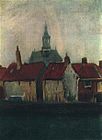







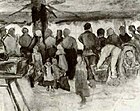


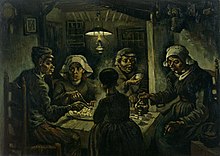



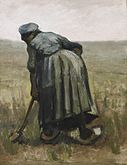
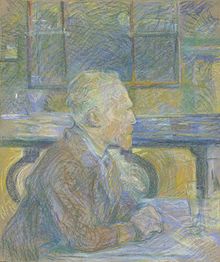


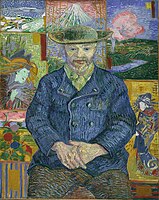


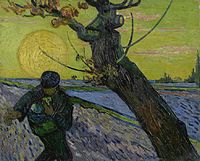


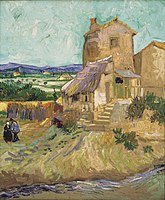






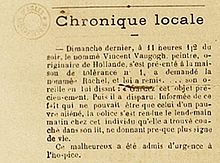


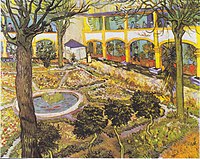



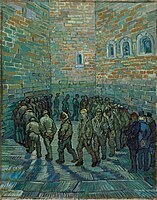

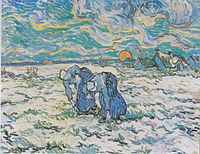


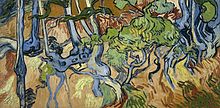



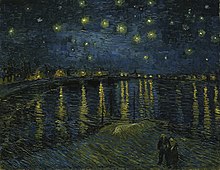
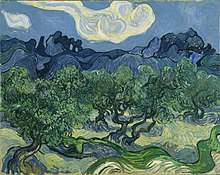



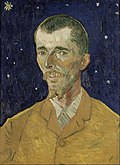

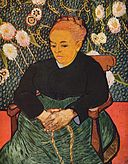






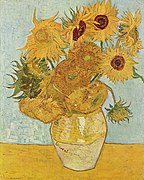


















This comment has been removed by the author.
ReplyDelete<3
DeleteTrue.